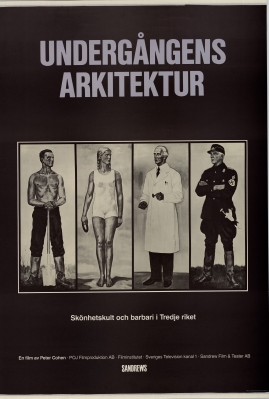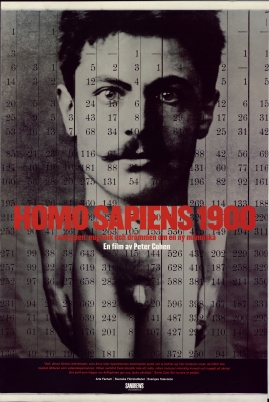Table of contents
- About the film
- Plot summary
- Swedish censorship / rating
- Technical specifications
- Comments
- Original work
Basic facts
Media (1)
| Original title | Undergångens arkitektur : Skönhetskult och barbari i Tredje rike |
|---|---|
| Film type | Feature |
| Category | Documentary |
| Director | |
| Producer | |
| Screenplay | |
| Production country |
|
| Production company | |
| Awards |
|
| Classification | Allowed from age 11 |
| Dialogue |
|
| Swedish release | 1989-10-13 |
Plot summary
The film explores the obsession Adolf Hitler had with his own particular vision of what was and was not aesthetically acceptable and how he applied these notions while running the Third Reich....
Promoted film contact
Kajsa Hedström
+46 8 665 11 22
kajsa.hedstrom@filminstitutet.se
Links and resources
Titles
| Original title |
|
|---|---|
| Swedish release title |
|
| International title |
|
| Distribution title |
|
| Title for Swedish Video release |
|
Crew
| Director | |
|---|---|
| Screenplay | |
| Producer | |
| Director of Photography | |
| Film Editor | |
| Production Mixer | |
| Research | |
| Color Timer | |
| Negative Cutter | |
| Sound Editor | |
| Re-recording Mixer | |
| Other Crew |
|
| Narrator |
|
Companies
| Production Company | Poj Filmproduktion AB | ||
|---|---|---|---|
| Stiftelsen Svenska Filminstitutet | |||
| Sveriges Television AB Kanal 1 | |||
| Sandrew Film & Teater AB | |||
| Distributor in Sweden (35 mm) | Sandrew Film & Teater AB | 1989 | |
| Distributor in Sweden (DCP) | Stiftelsen Svenska Filminstitutet | 2017 | |
| Distributor in Sweden (buy video) | Sandrew Film AB | ||
| Re-recording Mixer | FilmMixarna AB |
Plot summary
The film explores the obsession Adolf Hitler had with his own particular vision of what was and was not aesthetically acceptable and how he applied these notions while running the Third Reich. His obsession with art he considered pure, in opposition to the supposedly degenerate avant-garde works by Jewish and Soviet artists, reveals itself to be deeply connected to Hitler's equally subjective and strict ideal of physical beauty and health. A series of so-called degenerate art exhibitions were sponsored in order to depict modernist painting and sculpture as expressions of mental illness and general depravity. Classical art that reinforced Hitler's personal taste, from Roman statuary to Dutch oil paintings, was scavenged from across Nazi occupied Europe. Hitler is shown as an amateur architect, planning new building designs for the Third Reich that express his vision of a Nordic empire to rival those of classical antiquity. He is said to be intimately familiar with the grand opera houses of Europe. He visits Paris with a group of architects and artists who will be tasked with rebuilding Berlin to suit the Nazi aesthetic. Designs for new structures include depictions of the ruins they will make for distant generations. The film posits that Hitler's affinity for Greek and Roman antiquity is also expressed in his insistence of a totalizing strategy of war. In what Hitler imagined to be the style of Sparta and Rome, war was meant to annihilate the enemy, enslaving the population and erasing the history of the vanquished. (Source: Wikipedia)
Swedish censorship / rating
| Censorship number | 128707 |
|---|---|
| Date | 1989-10-09 |
| Classification | Allowed from age 11 |
| Original length | 3368 meters |
| Notes | Aktlängder: 590-545-500-557-521-527-128 m. |
Technical specifications
| Aspect ratio | 1.37:1 |
|---|---|
| Sound type | Sound |
| Sound system | Dolby Stereo |
| Colour type | Black and white + colour |
| Carrier type | 35 mm |
| Frames per second | 24 |
| Length in metres | 3368 meter |
| Length in minutes | 124 min |
| Reels | 7 reels |
| Dialogue |
|
Production location
| 1988-09 | 1988-12 |
Release dates
| Release in Sweden | 1989-10-13 | Sandrew | Gothenburg | Sweden | 123 min | (den tyska dialogen svensktextad) |
|---|---|---|---|---|---|---|
| 1989-10-13 | Grand | Stockholm | Sweden | 123 min | (den tyska dialogen svensktextad) | |
| TV showing | 1992-05-05 | Kanal 1 | Sweden | 118 min | ||
| Cinematheque screening, archive copy | 1995-01-04 | |||||
| Video release | 1995-04 | Sweden | 118 min | |||
| Cinematheque screening, archive copy | 1997-10-10 | |||||
| Non Swedish theater exkl FIAF | 2018-02-10 |
Soundtrack listing
| Original title | Cola Rienzi, der letzte der Tribunen | |
|---|---|---|
| Composer | Richard Wagner | (1842) |
| Lyrics | Richard Wagner | (1842) |
| Musical Arrangement | Sven Ahlin | (bearbetning) |
| Peter Cohen | (bearbetning) | |
| Orchestra | Sveriges Radios symfoniorkester | |
| Conductor | Okko Kamu |
| Original title | Requiem, kör, orkester, op. 5 | |
|---|---|---|
| Composer | Hector Berlioz | (1837) |
| Musical Arrangement | Sven Ahlin | |
| Peter Cohen | ||
| Orchestra | Sveriges Radios symfoniorkester | |
| Conductor | Okko Kamu |
Awards
| Festival Award | São Paulo | 1992 | (kritikerpriset) | ||
|---|---|---|---|---|---|
| Valladolid | 1991 | (1:a pris i dokumentärfilmklassen) |
Related films
| Kleinkrieg (1938) | Cited in | The Architecture of Doom (1989) |
| Der ewige Jude : Ein Filmbetrag zum Problem des Weltjudentums (1940) | Cited in | The Architecture of Doom (1989) |
| Opfer der Vergangenheit (1937) | Cited in | The Architecture of Doom (1989) |
| Bilden av förintelsen (1998) | The Architecture of Doom (1989) |
Holdings Film
The information given here refers to film material in the Swedish Film Institute’s archive. Access to the archive’s stock is given on request, for research, other film archives and rights’ holders. For enquiries please contact filmarkivet@filminstitutet.se
| Element type | |
|---|---|
| Carrier type | 35 mm |
| Element type | |
|---|---|
| Item base | Acetate |
| Carrier type | 35 mm |
| Element type | |
|---|---|
| Item base | Acetate |
| Carrier type | 35 mm |
| Element type | Duplicate positive |
|---|---|
| Carrier type | 35 mm |
| Length | 3368 |
| Element type | Original picture negative |
|---|---|
| Carrier type | 35 mm |
| Element type | Original picture negative |
|---|---|
| Carrier type | 35 mm |
| Element type | Original picture negative |
|---|---|
| Carrier type | 35 mm |
| Element type | Original picture negative |
|---|---|
| Carrier type | 35 mm |
| Element type | Sound negative |
|---|---|
| Carrier type | 35 mm |
| Element type | Sound negative |
|---|---|
| Carrier type | 35 mm |
| Element type | Sound negative |
|---|---|
| Carrier type | 35 mm |
| Element type | Sound negative |
|---|---|
| Carrier type | 35 mm |
| Element type | Intermediate audio recording |
|---|---|
| Carrier type | 35 mm |
| Element type | Final mix |
|---|---|
| Carrier type | 35 mm |
| Element type | Final mix |
|---|---|
| Carrier type | DAT |
| Element type | Final mix |
|---|---|
| Carrier type | DAT |
| Element type | Video tape digital |
|---|---|
| Carrier type | Digital Betacam (PAL) |
| Element type | Video tape digital |
|---|---|
| Carrier type | Digital Betacam (PAL) |
| Element type | Video tape digital |
|---|---|
| Carrier type | Digital Betacam (PAL) |
Holdings Posters
| Size | About 70 x 100 cm |
|---|---|
| Quantity | 2 |
Holdings Archive materials
| Type | Press Cuttings |
|---|
Holdings Scripts
| Script type | Inspelningsmanus |
|---|---|
| Script title | Undergångens arkitektur (arbetsnamn). Peter Cohen. |
| Extent | 22 s. + 10 s. illustrationer. Introduktion (5 s.) och researchresultat (4 s.) ingår. |
| Language | Swedish |
| Script type | Inspelningsmanus |
|---|---|
| Script title | Undergångens arkitektur. Peter Cohen. |
| Extent | 41 s. + 22 s. illustrationer. Introduktion (5 s.) och researchresultat (4 s.) ingår. |
| Language | Swedish |
| Script type | Dialoglista |
|---|---|
| Script title | Undergångens arkitektur. Textlista. |
| Extent | 12 s. |
| Language | Swedish |
| Script type | Dialoglista |
|---|---|
| Script title | Undergångens arkitektur. Textlista. |
| Extent | 9 s. |
| Language | German |
| Script type | Dialoglista |
|---|---|
| Script title | Undergångens arkitektur. |
| Extent | 62 s. |
| Language | Swedish |
| Script type | Dialoglista |
|---|---|
| Script title | Architektur des untergangs |
| Extent | 68 s. |
| Language | German |
| Script type | Dialoglista |
|---|---|
| Script title | A film by peter Cohen. Narrated by Bruno Ganz. The architecture of doom. |
| Extent | 60 s. |
| Language | English |
| Script type | Dialoglista |
|---|---|
| Language | English |
Holdings Stills
| Black and white print | 5 |
|---|---|
| Album | No |
Holdings Promotion materials
| Type | Program/Reklamtryck |
|---|
Other manifestations of this work
Digitized
Technical specifications
| Sound type | Sound |
|---|---|
| Colour type | Black and white + colour |
| Carrier type | DCP |
| Length in minutes | 124 min |
| Dialogue |
|
Holdings Film
| Element type | Digital audio |
|---|---|
| Carrier type | WAV |
| Element type | Digitalt visningsmaterial |
|---|---|
| Carrier type | DCP |
| Element type | Digitalt arkivmaterial |
|---|---|
| Carrier type | MAP |
| Element type | Digitalt arkivmaterial |
|---|---|
| Carrier type | MAP |
| Element type | Digitalt visningsmaterial |
|---|---|
| Carrier type | ProRes |
| Element type | Digitalt visningsmaterial |
|---|---|
| Carrier type | H264 |


